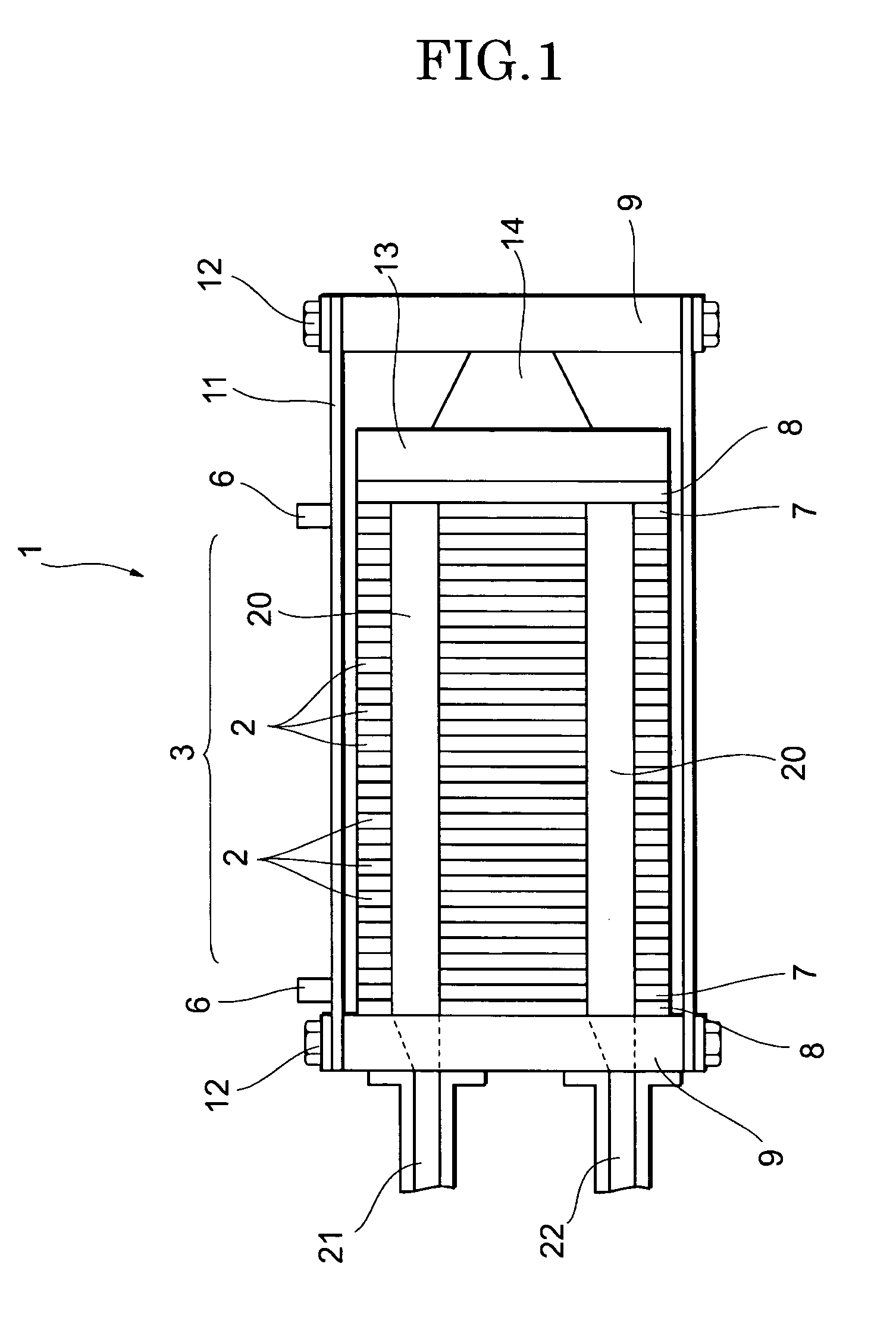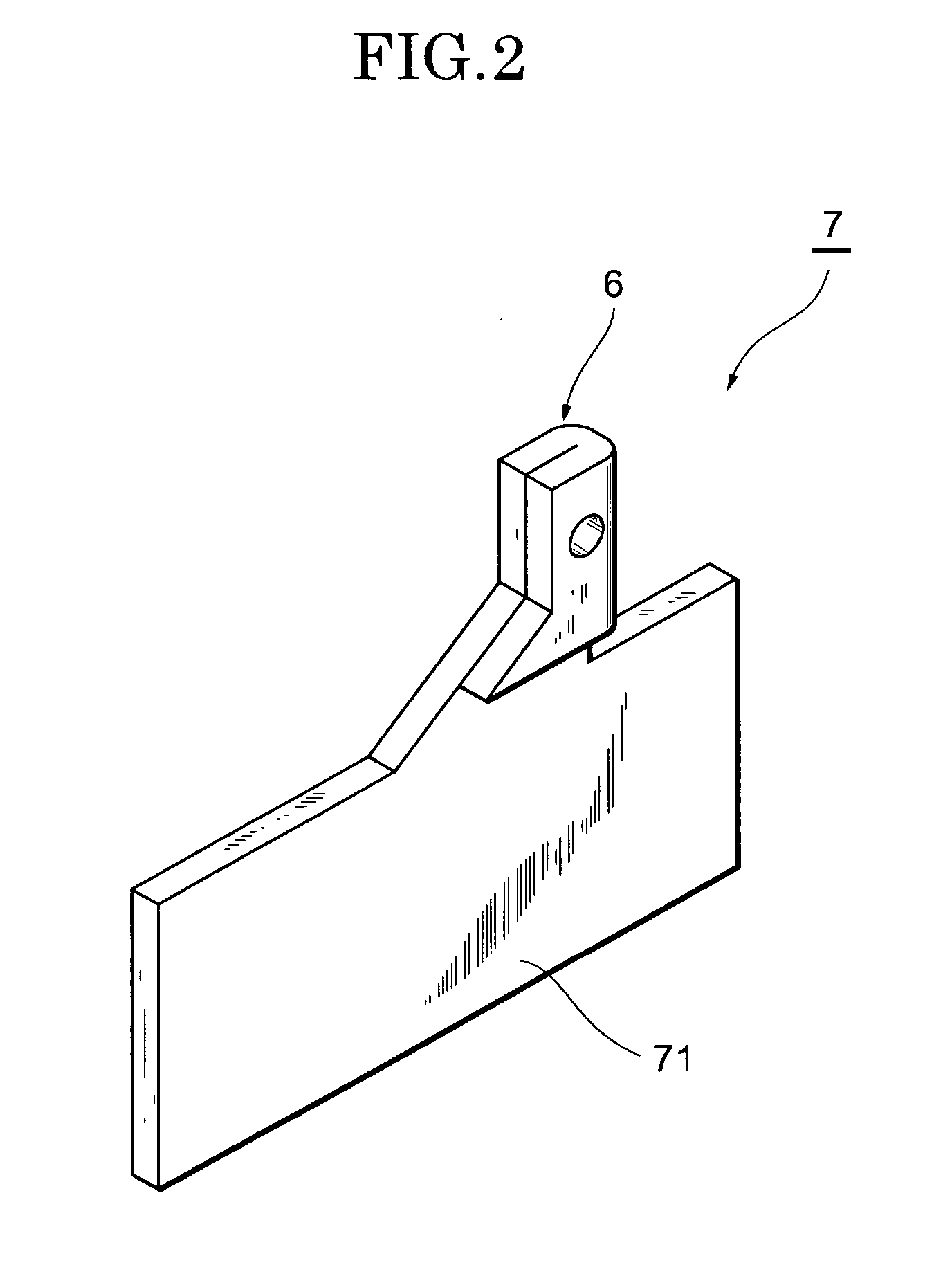Collecting plate, fuel cell, and method for manufacturing same
a technology of fuel cells and collecting plates, which is applied in the direction of cell components, final product manufacturing, sustainable manufacturing/processing, etc., can solve the problems of reducing the rigidity of the output terminal, affecting the start-up characteristics, and being more susceptible to damage or deterioration. , to achieve the effect of good rigidity, high-voltage resistance, and weight reduction
- Summary
- Abstract
- Description
- Claims
- Application Information
AI Technical Summary
Benefits of technology
Problems solved by technology
Method used
Image
Examples
first embodiment
Constitution of Fuel Cell
[0074]As shown in FIG. 1, a solid polymer type of fuel cell 1 has a stack 3 produced by stacking numerous single cells 2, which are the basic cells. The fuel cell 1 is the product of stacking a terminal plate 7 (collecting plate) with an attached output terminal 6, an insulating plate 8, and an end plate 9, in that order, on the outside of the single cells 2 located at each end of the stack 3.
[0075]Tension plates 11 provided spanning the two end plates 9, for example, are fixed by bolts 12 to the end plates 9, so that the fuel cell 1 is in a state in which a specific compressive force is exerted (applied) in the cell stacking direction. A pressure plate 13 and a spring mechanism 14 are provided between the insulating plate 8 and the end plate 9 at one end of the stack 3, so that fluctuations in the load exerted on the single cells 2 are absorbed.
[0076]Although not shown in the drawings, the single cells 2 are made up of a MEA (Membrane Electrode Assembly) co...
second embodiment
[0095]A second embodiment of the collecting plate pertaining to the present invention will now be described through reference to FIG. 6. The only differences in this second embodiment from the first embodiment discussed above are that an output terminal forming portion 33 is bent a plurality of times to form an output terminal 32, and that rigidity increasing means 31 is provided to the output terminal forming portion 33, with the rest of the constitution being the same as in the first embodiment.
[0096]In the first embodiment above, an example was described in which the plate thickness of the collecting section 71 was only half that the conventional thickness, and the output terminal 6 was formed by bending the output terminal forming portion 61 just one time, but in this second embodiment, a situation will be described in which the plate thickness of the collecting section 71 is even thinner than in the past (such as one-fourth) in an effort to further reduce the thermal capacity a...
third embodiment
[0101]A third embodiment of the collecting plate pertaining to the present invention will now be described through reference to FIG. 7. The only differences in this third embodiment from the first embodiment discussed above are that an output terminal 52 is formed without bending an output terminal forming portion 51, and that rigidity increasing means 53 is provided to the output terminal forming portion 51, with the rest of the constitution being the same as in the first embodiment.
[0102]Specifically, a terminal plate 50 (collecting section) in this embodiment comprises the rigidity increasing means 53, in the form of a kind of buttress, provided to the proximal end 54 of the output terminal forming portion 51 connecting to the collecting section 71. As shown in FIG. 7, the width L1 of the proximal end 54 of the collecting section 71 in the planar direction (the lengthwise direction of the collecting section 71 in FIG. 7) and the width L0 of the output terminal 52 in the planar di...
PUM
| Property | Measurement | Unit |
|---|---|---|
| thickness | aaaaa | aaaaa |
| rigidity | aaaaa | aaaaa |
| width | aaaaa | aaaaa |
Abstract
Description
Claims
Application Information
 Login to View More
Login to View More - R&D
- Intellectual Property
- Life Sciences
- Materials
- Tech Scout
- Unparalleled Data Quality
- Higher Quality Content
- 60% Fewer Hallucinations
Browse by: Latest US Patents, China's latest patents, Technical Efficacy Thesaurus, Application Domain, Technology Topic, Popular Technical Reports.
© 2025 PatSnap. All rights reserved.Legal|Privacy policy|Modern Slavery Act Transparency Statement|Sitemap|About US| Contact US: help@patsnap.com



